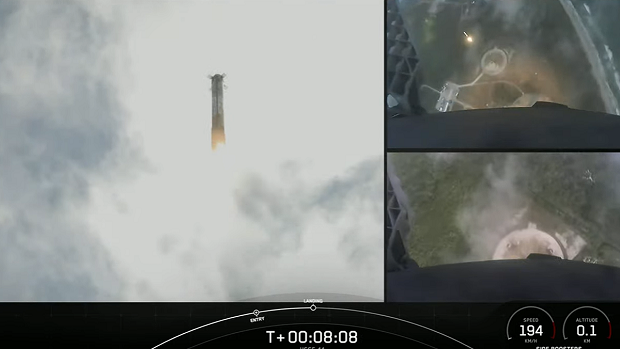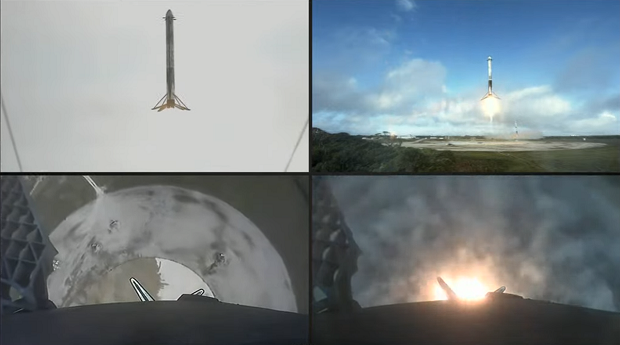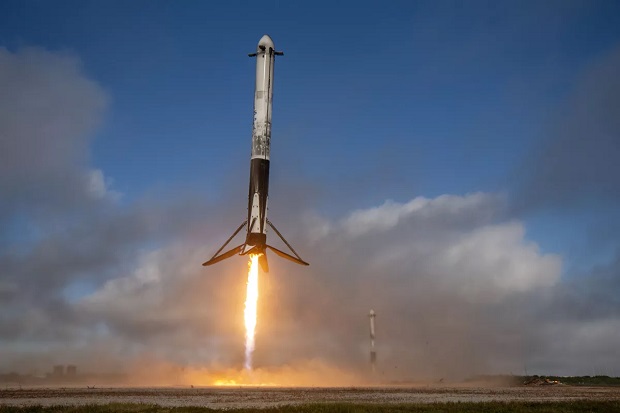
SpaceX's Falcon Heavy makes first flight since 2019, puts US military satellite into orbit
SpaceX launched the Falcon Heavy rocket—which is considered the most powerful rocket in the world—for the first time since 2019. The Falcon Heavy has most likely taken into space US military satellites.
Until the end of the year, SpaceX plans to carry out another important launch and test the Starship system.
SpaceX's Falcon Heavy rocket launch
The rocket, which consists of three modified Falcon 9 first-stage boosters connected together, launched from Pad 39A at NASA's Kennedy Space Center (KSC) at 09:41 EST (18:41 Armenia time) on Tuesday in dense fog conditions.
This is the fourth launch of the Falcon Heavy rocket in total and the first since June 2019. The company's "workhorse" Falcon 9 is in much more frequent use, flying into space at least once a week this year. In the vast majority of cases, already used boosters were used in order to launch the Falcon 9. Falcon Heavy was launched this time with three completely new boosters for the first stage.

As the countdown clock hit zero, all 27 Merlin engines in Falcon Heavy's first stage kicked into action with 64 metric tons of thrust to lift the huge and very heavy rocket. About 2.5 minutes after launch, the two side boosters separated to perform synchronized acceleration and begin the return to Cape Canaveral.
In previous Falcon Heavy missions, experts attempted to land the central booster on one of SpaceX's autonomous unmanned spacecrafts in the Atlantic Ocean. Now, the orbital and mass load requirements of the USSF-44 mission demand that the rocket's main booster not be landed and used later; this will enable the maximum amount of fuel to be allocated to launch the rocket into direct geostationary orbit.

About four minutes after launch, Falcon Heavy's central accelerator separated from the upper part and began to descend towards the “watery grave” in the Atlantic Ocean. Meanwhile, the upper section fired its single Merlin engine to lift the satellites higher into orbit. Shortly thereafter, the two halves of USSF-44's payload fairing separated from the rocket and returned to Earth's atmosphere. SpaceX plans to recover both for future reuse.
Eight minutes after launch, Falcon Heavy's two side boosters landed simultaneously on Zones 1 and 2 of the SpaceX Landing Station in Cape Canaveral.
What does the Falcon Heavy carry?
As part of the mission called USSF-44, the Falcon Heavy delivered the LDPE-2 device created by the Northrop Grumman aerospace company into geostationary orbit—at an altitude of 35,400 kilometers above the Earth. It's something like a space bus that carries six pieces of secret cargo for the US Space Force.
"The LDPE-2 space vehicle will deliver six payloads that advance communications, space weather sensing and other technologies into near-geosynchronous orbits," the US Space Force said in a statement.

According to Gizmodo.com, one of the payloads is likely a US military communications satellite. Since information about it is classified, one can only guess about its characteristics and purposes.
The cargo also includes the TETRA-1 satellite prototype, built by Boeing's subsidiary Millennium Space Systems, and Lockheed Martin's CubeSat-type LInuss-A 1 and LInuss-A 2 devices.
Another important mission of SpaceX until end of 2022
In December, SpaceX plans to carry out one of the most important launches of the year and fully test the Starship system. During the demonstration flight, the 70-meter Super Heavy rocket will deliver the 50-meter Starship spacecraft into near Earth’s orbit.
According to the plan, after the launch, the Super Heavy rocket will return to the Earth, whereas the Starship spacecraft will make an orbital flight for 90 minutes, after which it will return to the Earth's atmosphere and land several tens of miles from the coast of Hawaii.
SpaceX has previously only conducted test launches of the Starship prototype to altitudes of up to 10 kilometers to test systems and landings. Several times the spacecraft exploded during landing, but later the experts managed to fix it.
NASA chose the Starship spacecraft to take people to the Moon in 2025, after which a contract worth about $3 billion was signed with the company. Until 2025, SpaceX must perform several tests of its system in orbit.
- Related News
- Perseverance finds rock on Mars with signs of life on Earth (photo)
- On 25th anniversary of Chandra telescope, NASA released 25 photos previously unseen by the public
- Rare intermediate-mass black hole has been discovered at the center of our galaxy
- Stone "snowman" and pure sulfur crystals on Mars։ Remarkable discoveries by Perseverance and Curiosity
- When will humanity settle on Mars? Interview with Gernot Grömer
- TESS telescope discovers super-hot exoplanet the size of Neptune
- Most read
month
week
day
- Buyers massively complain about Samsung's Galaxy Buds 3 and Buds 3 Pro headphone, even finding hair in the box 821
- With today's mortgage interest rates, banks simply cannot sell products in 2025: Interview with Vardan Marutyan 812
- Ants and bees 'taught' tiny drones to navigate without GPS, beacons or lidars 676
- Samsung will release Galaxy Tab S10+ and Ultra tablets and Galaxy Z Fold 6 Slim and Galaxy w25 smartphones in October 641
- Mass production of iPhone SE 4 will begin this October, with sales starting in 2025 602
- Insider unveils specs of all smartphones of iPhone 17 series, including the 17 Slim 595
- Telegram's monthly active audience reaches 950 million 585
- For the first time in history, iPhone will get a Samsung camera 555
- What dangers can feature phones from unknown manufacturers conceal? 554
- What are the problems in the construction industry? Interview with Vardan Marutyan 549
- Archive
